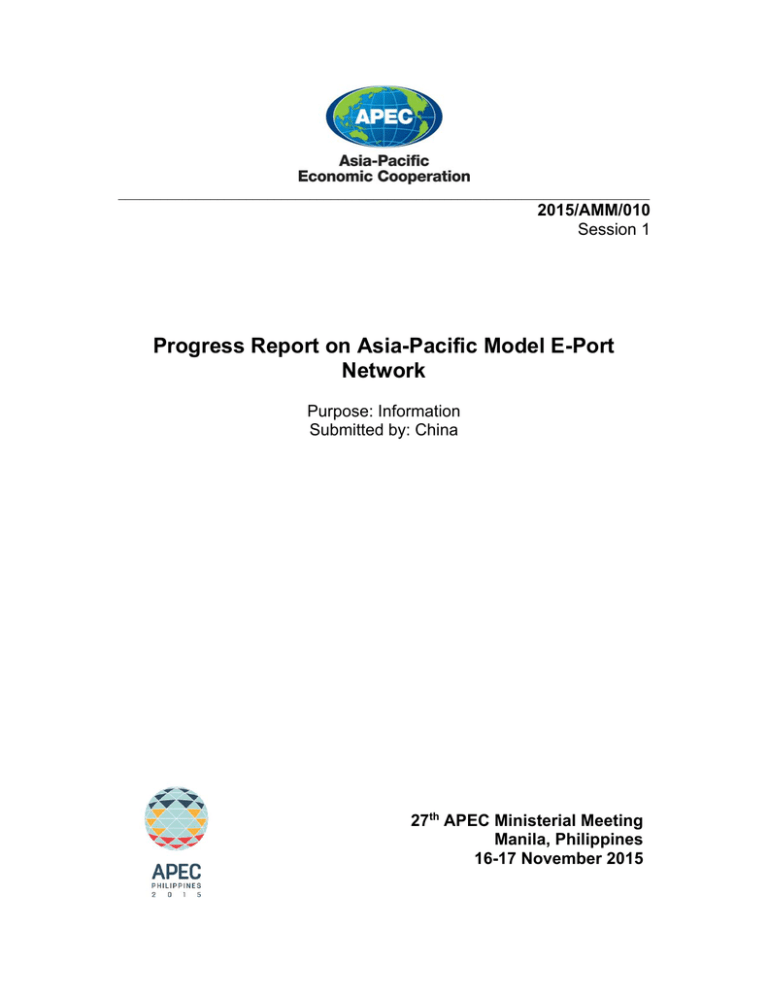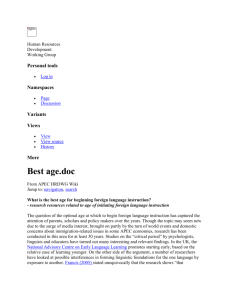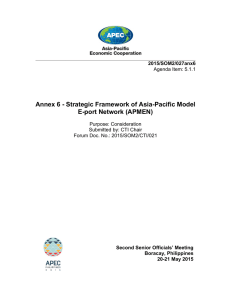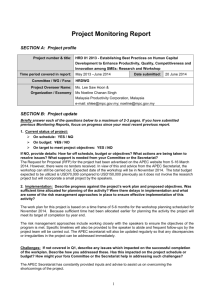Progress Report on Asia-Pacific Model E-Port Network
advertisement

___________________________________________________________________________ 2015/AMM/010 Session 1 Progress Report on Asia-Pacific Model E-Port Network Purpose: Information Submitted by: China 27th APEC Ministerial Meeting Manila, Philippines 16-17 November 2015 Executive Summary: To implement the instruction of APEC leaders on APMEN, abundant efforts have been made and remarkable progress has been achieved. Hence, we would like to report to APEC Ministers what we achieved and what activities we have held for the guidance on the next steps. Required Action/ Decision Points: It is recommended that Ministers note this progress report for reference. 1 Progress Report on Asia-Pacific Model E-Port Network Purpose: For Information Submitted by: China Background In 2014, APEC Leaders agreed to establish the Asia-Pacific Model E-port Network (APMEN), endorsed the Terms of Reference of the Asia-Pacific Model E-Port Network, and welcomed the first batch of APEC Model E-ports nominated by the APEC economies. Moreover, APEC Leaders agreed to set up the APMEN operational centre in the Shanghai Model E-port and instructed senior officials to make further efforts to contribute to the development of APMEN. Progress Abiding by leaders’ mandates, APMEN members have been intensifying their work to accelerate the development of APMEN in an effective way. In February 2015, SOM1 and CTI1 approved 2015 APMEN Work Plan. In May, SOM2 endorsed APMEN Strategic Framework and Working Mechanism. Trade Ministers recognized the contribution of E-port development and welcomed the results of the first APMEN Joint Operator Group (AJOG). According to the aforementioned documents, AJOG took the following actions as agreed to promote the development of APMEN: Circulated questionnaire to understand the situation and needs of APMEN members on developing E-port According to APMEN Term of Reference and Work Plan, a survey has been carried out to get an initial understanding of current ICT infrastructure development of each APMEN model ports. Until now, questionnaires have been circulated and the feedbacks are still collecting. The information will be extracted to prepare the related report. It is envisioned to submit the report to CTI1 in 2016. Visited Shanghai Model E-Port On August 20, 2015, a field visit to Shanghai Model E-port was organized by Shanghai 2 operational center. Over 20 participants from APMEN members and other APEC economies, including Australia, Canada, China, Hong Kong, China, Japan, Malaysia, Mexico, Papua New Guinea, Peru, the Philippines, Singapore, Thailand and Viet Nam, attended this activity and learned about the development of Shanghai Model E-port in details. The contents include the definition, structure, functions, services as well as the applications of new ICT, such as cloud platform for shipping service. Representatives also understood the operation models of Shanghai Single Window System for international trade, KJT an operator of cross-border e-commerce and Easipay of an operator of payment for duties and taxes. Inaugurated Asia-Pacific Model E-Port Network (APMEN) and APMEN Operational Centre (AOC) and Launched APMEN Website On August 21, 2015, over 200 participants from public and private sectors attended the Inauguration Ceremony of APMEN and APMEN Operational Centre (AOC) in Shanghai, China. After then, APMEN and AJOG of Committee (AOC) were officially inaugurated. APMEN website started running formally. Held an APEC Public-Private Dialogue on Advancing Trade Facilitation & Supply Chain Connectivity through APMEN On August 21, the first APMEN Public-Private Dialogue was held with over 200 participants and 7 speakers attended. The topics of presentations include: Insights of Cross-Border E-commerce, Mutual Recognition of Electronic Certificate of Origin, Cross-Border End-to-end Supply Chain Visibility, Air Cargo Cloud Platform for Cross Border Supply Chain Connectivity, Shipping Big Data Applications Solutions Research and Australian Port Community Systems Project Introduction etc. Held the second APMEN Joint Operational Group (AJOG) On August 21, 2015, the second AJOG was held in Shanghai. China. Australia, Canada, China, Hong Kong, China, Malaysia, Peru and Viet Nam sent representatives to attend the meeting. Some observers such as Japan, Papua New Guinea, the Philippines, Singapore and Thailand, assigned representatives. The meeting had discussions on five topics: 1. Welcome Malaysia to join APMEN; 2. Discuss the ways of conducting a literature review on E-ports to improve 3 economies understanding, including collaboration with the Sub-Committee on Customs Procedures (SCCP), and cooperation with the SCCP on the review of existing literature and work on e-ports; 3. Discuss the ways of implementing case studies on how economies use ICT infrastructure in their ports and single window program; 4. Discuss the ways to explore pilot projects and solution studies in specific areas of model e-ports; 5. Discuss on how to implement APMEN’s Working Mechanism and Strategic Framework according to APMEN’s work plan 2015. The summary report has been circulated by APEC Secretariat. Next Steps E-Port Literature Review Conduct a literature review of the existing and ongoing E-port and submit a summary report. This report will enhance the understanding among APEC economies through explaining what E-Port is, how it can benefit APEC’s supply chain connectivity and trade facilitation, what are the salient characteristics of an E-Port, how to construct and develop E-Port, and how an E-Port can help economies accomplish their domestic objectives. Carry out case studies on using ICT Infrastructure in Ports and Single Window Programmes Identify a number of Model E-ports and good practices in the Asia-pacific region by case studies. The outputs of the case studies will be shared among APMEN members. Pilot Projects and Solution Studies on Advancing Trade Facilitation and Supply Chain Connectivity through APMEN The initiative titled Advancing Trade Facilitation and Supply Chain Connectivity through APMEN was proposed and approved at the APEC Public-Private Dialogue held in Shanghai, China on August 21, 2015. The pilot projects and solution studies officially kicked off. 4




